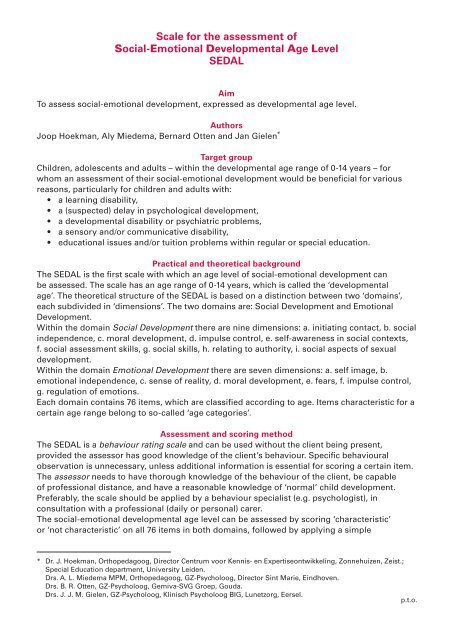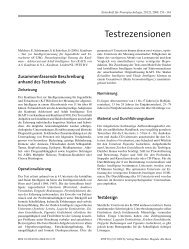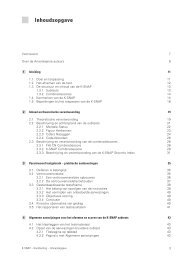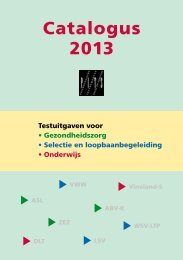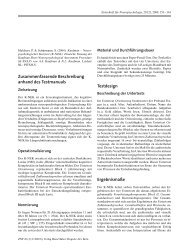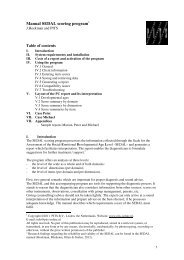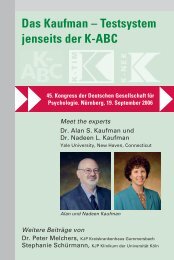Scale for the assessment of Social-Emotional Developmental ... - Pits
Scale for the assessment of Social-Emotional Developmental ... - Pits
Scale for the assessment of Social-Emotional Developmental ... - Pits
Create successful ePaper yourself
Turn your PDF publications into a flip-book with our unique Google optimized e-Paper software.
<strong>Scale</strong> <strong>for</strong> <strong>the</strong> <strong>assessment</strong> <strong>of</strong><br />
<strong>Social</strong>-<strong>Emotional</strong> <strong>Developmental</strong> Age Level<br />
SEDAL<br />
Aim<br />
To assess social-emotional development, expressed as developmental age level.<br />
Authors<br />
Joop Hoekman, Aly Miedema, Bernard Otten and Jan Gielen *<br />
Target group<br />
Children, adolescents and adults – within <strong>the</strong> developmental age range <strong>of</strong> 0-14 years – <strong>for</strong><br />
whom an <strong>assessment</strong> <strong>of</strong> <strong>the</strong>ir social-emotional development would be beneficial <strong>for</strong> various<br />
reasons, particularly <strong>for</strong> children and adults with:<br />
• a learning disability,<br />
• a (suspected) delay in psychological development,<br />
• a developmental disability or psychiatric problems,<br />
• a sensory and/or communicative disability,<br />
• educational issues and/or tuition problems within regular or special education.<br />
Practical and <strong>the</strong>oretical background<br />
The SEDAL is <strong>the</strong> first scale with which an age level <strong>of</strong> social-emotional development can<br />
be assessed. The scale has an age range <strong>of</strong> 0-14 years, which is called <strong>the</strong> ‘developmental<br />
age’. The <strong>the</strong>oretical structure <strong>of</strong> <strong>the</strong> SEDAL is based on a distinction between two ‘domains’,<br />
each subdivided in ‘dimensions’. The two domains are: <strong>Social</strong> Development and <strong>Emotional</strong><br />
Development.<br />
Within <strong>the</strong> domain <strong>Social</strong> Development <strong>the</strong>re are nine dimensions: a. initiating contact, b. social<br />
independence, c. moral development, d. impulse control, e. self-awareness in social contexts,<br />
f. social <strong>assessment</strong> skills, g. social skills, h. relating to authority, i. social aspects <strong>of</strong> sexual<br />
development.<br />
Within <strong>the</strong> domain <strong>Emotional</strong> Development <strong>the</strong>re are seven dimensions: a. self image, b.<br />
emotional independence, c. sense <strong>of</strong> reality, d. moral development, e. fears, f. impulse control,<br />
g. regulation <strong>of</strong> emotions.<br />
Each domain contains 76 items, which are classified according to age. Items characteristic <strong>for</strong> a<br />
certain age range belong to so-called ‘age categories’.<br />
Assessment and scoring method<br />
The SEDAL is a behaviour rating scale and can be used without <strong>the</strong> client being present,<br />
provi ded <strong>the</strong> assessor has good knowledge <strong>of</strong> <strong>the</strong> client’s behaviour. Specific behavioural<br />
observation is unnecessary, unless additional in<strong>for</strong>mation is essential <strong>for</strong> scoring a certain item.<br />
The assessor needs to have thorough knowledge <strong>of</strong> <strong>the</strong> behaviour <strong>of</strong> <strong>the</strong> client, be capable<br />
<strong>of</strong> pr<strong>of</strong>essional distance, and have a reasonable knowledge <strong>of</strong> ‘normal’ child development.<br />
Preferably, <strong>the</strong> scale should be applied by a behaviour specialist (e.g. psychologist), in<br />
consultation with a pr<strong>of</strong>essional (daily or personal) carer.<br />
The social-emotional developmental age level can be assessed by scoring ‘characteristic’<br />
or ‘not characteristic’ on all 76 items in both domains, followed by applying a simple<br />
* Dr. J. Hoekman, Orthopedagoog, Director Centrum voor Kennis- en Expertiseontwikkeling, Zonnehuizen, Zeist.;<br />
Special Education department, University Leiden.<br />
Drs. A. L. Miedema MPM, Orthopedagoog, GZ-Psycholoog, Director Sint Marie, Eindhoven.<br />
Drs. B. R. Otten, GZ-Psycholoog, Gemiva-SVG Groep, Gouda.<br />
Drs. J. J. M. Gielen, GZ-Psycholoog, Klinisch Psycholoog BIG, Lunetzorg, Eersel.<br />
p.t.o.
ma<strong>the</strong>matical <strong>for</strong>mula. If required, <strong>the</strong> SEDAL can also be used <strong>for</strong> additional qualitative<br />
analysis <strong>of</strong> <strong>the</strong> social and emotional dimensions. A computer program can generate <strong>the</strong>se data.<br />
Psychometric results and norms<br />
The evaluation <strong>of</strong> <strong>the</strong> age category <strong>of</strong> each item is based on <strong>the</strong> pr<strong>of</strong>essional expertise <strong>of</strong><br />
47 kindergarten and primary school teachers with (normally developing) children in The<br />
Ne<strong>the</strong>rlands and Flanders (Belgium).<br />
Interrater reliability and test-retest reliability were investigated in research groups <strong>of</strong> 59 and<br />
25 clients respectively. Expressed in Cohen’s kappa, <strong>the</strong> agreement on item level is sufficient<br />
to excellent in 90-94% <strong>of</strong> <strong>the</strong> items. Pearson correlations between <strong>the</strong> two ratings per person<br />
range from .88 to .95 (interrater reliability) and from .89 to .97. (test-retest reliability).<br />
Validity research results in high coefficients <strong>for</strong> concurrent validity with <strong>the</strong> <strong>Scale</strong> <strong>for</strong> <strong>Social</strong><br />
Self Care <strong>for</strong> people with intellectual disabilities [<strong>Social</strong>e Redzaamheidsschaal Zwakzinnigen]<br />
(Kraijer, Kema & De Bildt, 2004), <strong>the</strong> Vineland-Z (De Bildt & Kraijer, 2003) and several measures<br />
<strong>of</strong> intelligence: Pearson correlations range from 0.60 to 0.80. Investigating discriminating<br />
validity, <strong>the</strong> SEDAL scale measures – as expected – different concepts than <strong>the</strong> Challenging<br />
Behaviour <strong>Scale</strong> <strong>for</strong> people with Intellectual disabilities [Storend Gedragsschaal voor<br />
Zwakzinnigen] (Kraijer en Kema, 1994): <strong>the</strong> Pearson correlation between <strong>the</strong> two scales is 0.05.<br />
Materials<br />
• Manual<br />
• Scoring <strong>for</strong>ms <strong>for</strong> assessing <strong>the</strong> social-emotional developmental age level<br />
• Computer program <strong>for</strong> generating qualitative in<strong>for</strong>mation per dimension<br />
Publication<br />
English edition (SEDAL) expected end 2010 / beginning 2011<br />
Deutsche Version (SEN) erwartet Ende 2010 / Anfang 2011.<br />
Dutch version (ESSEON) available since 2007. Revised edition scheduled <strong>for</strong> end 2010 /<br />
beginning 2011.<br />
Ordering details<br />
In<strong>for</strong>mation and prices will be available on <strong>the</strong> web site <strong>of</strong> PITS: www.pits-online.nl/en and<br />
www.pits-online.nl/de.<br />
You would like to be kept in<strong>for</strong>med?<br />
If you would like to receive <strong>the</strong> details (prices, publication date, ordering procedure) as soon as<br />
<strong>the</strong>y are available, please send us an email with <strong>the</strong> details below, indicating that your interest<br />
concerns <strong>the</strong> (English / German) publication:<br />
Name .........................................................................................................................................................................................................<br />
Organisation .........................................................................................................................................................................................<br />
Address ....................................................................................................................................................................................................<br />
Telephone and Fax number ........................................................................................................................................................<br />
E-mail address .....................................................................................................................................................................................<br />
PITS B.V., Test publishers<br />
Middelstegracht 89 v<br />
NL-2312TT Leiden<br />
The Ne<strong>the</strong>rlands<br />
Tel: +31 (0)71-5318786<br />
Fax: +31 (0)71-5728165<br />
URL: www.pits-online.nl.<br />
E-mail: Info@pits-online.nl<br />
September 2010


